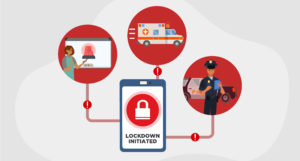Listen to this blog
4 minutes
In the rapidly evolving landscape of school safety, behavioral threat assessments (BTA) have emerged as a crucial tool to preempt potential dangers and maintain a safe environment. However, administering these assessments presents unique challenges, spanning from identifying credible threats to maintaining accurate documentation of your team’s response to threats.
Modernizing the tools used in threat assessment cases can help schools navigate these complexities, enhancing overall school safety and student outcomes.
Let’s look at three common challenges to effective behavioral threat assessments—and how having a single platform to manage and support the wellbeing of individual students can help ensure your teams are conducting the methodologies with fidelity.
Understanding the Challenges
1. Threat Identification
- Evaluating Threat Severity: One significant challenge is determining the level of response warranted by the myriad of threats schools encounter, with some less clear-cut than others.
Firstly, understanding the wide range of threats that can emerge in a school setting, and determining the appropriate level of response, is a significant challenge. Online threats, whether through Google Classroom or social media, add another layer of complexity. Deciphering the line between a casual remark and a serious threat is often tricky and can lead to either overreaction or underestimation.
- Digital Dilemma: The increasing use of online platforms like Google Classroom and social media has blurred the lines between harmless jokes and genuine threats. Educators often find it difficult to make the right call.
- Consistency in Implementation: Inconsistencies in the application of BTAs can raise concerns during state audits. Such inconsistencies also waste valuable time that could be better used for constructive educational activities.
Raptor StudentSafe™, with its comprehensive BTA case management system and customizable categories, helps teams follow established protocols, maintain protocol fidelity, and make informed decisions. By reducing administrative tasks and providing real-time insights through alerts and dashboards, StudentSafe empowers teams to focus on students’ well-being and create proactive, student-centered programs to prevent violence.
2. Role Clarity
Educators, not law enforcement professionals, are typically at the forefront of behavioral threat assessments. Consequently, making the complex BTA process digestible and practical for educators is a common hurdle. The process’s implementation can vary significantly from campus to campus, raising concerns about consistency and possible state audit questions, and tracking case progress accurately is difficult to achieve in traditional methods.
StudentSafe facilitates communication and collaboration among team members, even if they are in different locations. Throughout assessment and case management in StudentSafe—which uses proven BTA methodologies—teams can quickly share information and efforts to ensure a coordinated response. With StudentSafe, you can assign tasks to other staff to distribute workload and facilitate progress, and also set reminders and alerts to help team members manage cases and focus on the student.
3. Documentation and Reporting
Compiling, reporting, and analyzing threat assessment data is often tedious, manual, and time-consuming. This difficulty is compounded by increasing demands for transparency and accountability in school safety measures.
Leveraging technology enables you to streamline your existing process so you and your team can focus on the student. Providing a central repository with StudentSafe gives teams a secure place to gather and share data, which makes it easier to analyze the data to identify patterns and potential warning signs so teams can make informed decisions.
Modernize your BTA process with Raptor
The BTA process is undoubtedly complex, with numerous challenges. However, with a combination of robust technology, a shift towards understanding student behavior, and a commitment to continuous improvement, schools can significantly enhance their safety measures while maintaining a focus on student wellbeing.
For more strategies to support students in distress and reduce violence, see Raptor’s free guide on student wellbeing.
Related Resources
Guide to K-12 Student Wellbeing
Strategies to Recognize, Document, and Support Students in Distress
Listen to this blog
4 minutes






